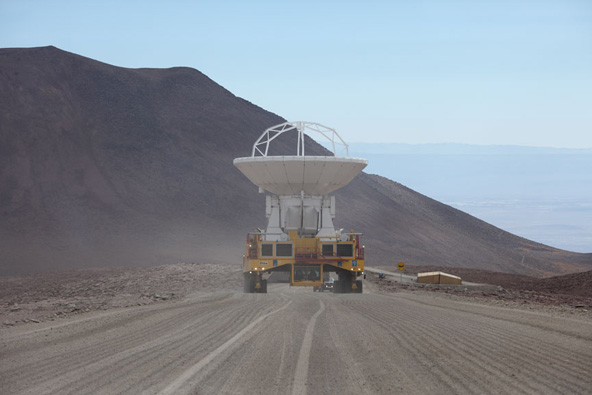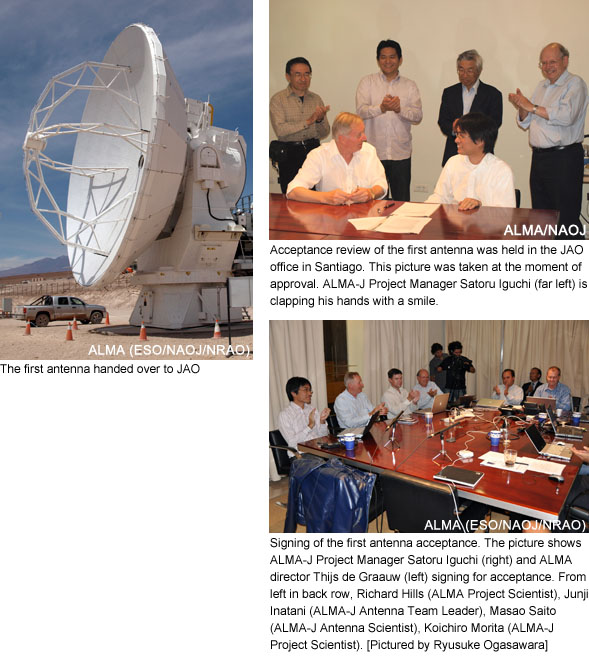The twelfth 7-m antenna developed by Japan was delivered to the high site in Chajnantor on April 29, 2013. Now all the 16 antennas of the Atacama Compact Array (ACA) are installed at the Array Operations Site at the altitude of 5,000 m and awaiting to unveil secrets of the universe.
ALMA, the Atacama Large Millimeter/submillimeter Array, is an international partnership of East Asia, Europe and North America in cooperation with the Republic of Chile, to build a giant radio telescope by connecting 66 high precision antennas. In this global venture, Japan is responsible for the development of 16 antennas (four 12-m antennas and twelve 7-m antennas), ultra-cooled radio receivers for three frequency bands which are installed in all the 66 antennas, and high-speed computer, or the correlator, to combine the signals collected by Japanese 16 antennas. The Atacama Compact Array, a major deliverable from Japan to the ALMA project, consists of the 16 antennas and receivers installed therein and the ACA correlator. The ACA is able to correct the radio waves emanated from celestial objects with a large angular size, such as molecular clouds and nearby galaxies, and make ALMA’s radio image fidelity higher.
The last 7-m antenna was loaded on a custom-build transporter and left ALMA’s Operation Support Facility (OSF, at the altitude of 2900 m above sea level) at 10:30 on April 29th. After the six hours of careful transportation, the antenna was placed at the right position in the AOS on 17:30. It was three and a half years after the transportation of the first antenna to the high site in 2009. (More information: Press Release Sep 18, 2009 Japanese ALMA antenna became the first to arrive at the ALMA 5000 m site. )
Satoru Iguchi, the East Asia ALMA Project Manager and professor at National Astronomical Observatory of Japan (NAOJ), looks back on the history of the construction of ALMA and saying “Japan formally joined to the ALMA project in 2004 and finished to build 16 ACA antennas in 2012. Today, we finally placed all the ACA antennas to the high site. Since the environment at Chajnantor is very harsh and it is tough to operate the antennas there, the antennas have to pass various verification tests at the OSF before starting the operation at AOS. The antennas are full of the precision instruments and the number of verification items was enormous. This wonderful milestone of the completion of the ACA antennas was achieved by the countless efforts of the NAOJ ALMA antenna team led by Norikazu Mizuno, the East Asia ALMA System Engineering and System Integration Manager, as well as all the related staff in the Joint ALMA Observatory (JAO). Now, the ACA starts to show its full capability. With the inclusion of ACA, ALMA can produce high-fidelity radio images to understand the birth and evolution of planetary systems and galaxies, and hopefully the origin of life.”
Click to Enlarge (JPEG/ 272KB)
Figure 2. Staff from NAOJ, JAO, and the antenna constructor Mitsubishi Electric in front of the final 7-m antennas just after the transportation.
Credit: ALMA (ESO/NAOJ/NRAO), O. Mendez (NAOJ)
Click to Enlarge (JPEG/ 983KB)
Figure 3. ACA antennas at Chajnantor. Antennas built by North America and Europe are also seen in the right deep area.
Credit: ALMA (ESO/NAOJ/NRAO), O. Mendez (NAOJ)
high resolution (TIFF/ 36.2MB)
Precede this completion by a month, in March 2013, the ALMA Board unanimously decided that the ACA is named the “Morita Array” after Professor Koh-ichiro Morita, one of the world’s renowned scientists in the field of “aperture synthesis” and suddenly passed away on May 7th 2012 in Santiago. This is the first time to name a telescope after a Japanese astronomer.
Koh-ichiro Morita, a professor at the NAOJ Chile Observatory, was engaged in the construction of the Nobeyama Millimeter Array in the 1980’s, and in the 2000’s he joined in the ALMA project. He made a great contribution to designing the configuration of 16 antennas composing the ACA, as well as to realizing high-resolution and high-quality imaging at millimeter/submillimeter wavelengths to further enhance the performance of ALMA. In 2010, he became a member of the JAO in Chile and served as leader of an international team of scientists to carry out system verification and evaluation of ALMA.
“Professor Morita played a central role to build the concept of ACA and made it reality as the largest contribution from Japan to ALMA. All our partners are delighted to give his name to the array.” told Masahiko Hayashi, the Director General of the NAOJ. “Although it is hard to overcome the sadness of his loss, this new name after Professor Morita relieves us.”
As described above, the Morita Array is designed for precise imaging of extended celestial objects. Professor Morita is the one who derived the best configuration of the array, that is, the proper number and the diameters of the antennas, with numerous computer simulation studies. The system verification observations clearly showed that Professor Morita’s design of the array accomplished the objective, and the Morita Array is used for scientific observations now. The telescope with Professor Morita’s name will add new pages to astronomy with its unique function as his anticipation.
ALMA

-
Click to Enlarge (JPEG/335 KB)
ALMA artist conception
Credit: ALMA(ESO/NAOJ/NRAO)









